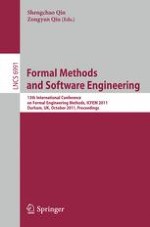This book constitutes the refereed proceedings of the 13th International Conference on Formal Engineering Methods, ICFEM 2011, held in Durham, UK, October 2011. The 40 revised full papers together with 3 invited talks presented were carefully reviewed and selected from 103 submissions. The papers address all current issues in formal methods and their applications in software engineering. They are organized in topical sections on formal models; model checking and probability; specification and development; security; formal verification; cyber physical systems; event-B; verification, analysis and testing; refinement; as well as theorem proving and rewriting.
